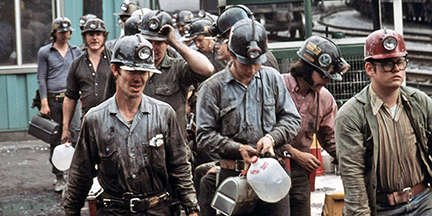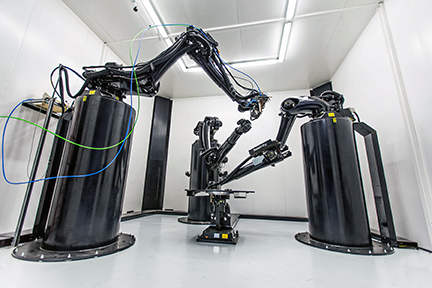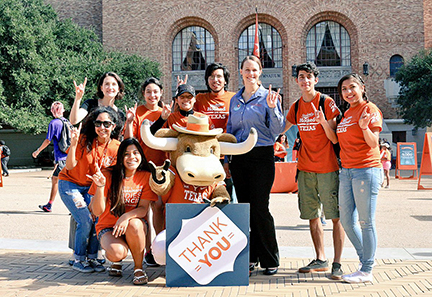 Houston-based Cheniere Energy’s LNG export facility will long be remembered in the history of energy in the United States as a trailblazer for an industry that is growing faster than any other. Cheniere originally built an LNG import plant in Cameron Parish in Southwest Louisiana. That was back when the U.S. wasn’t swimming in natural gas.
Houston-based Cheniere Energy’s LNG export facility will long be remembered in the history of energy in the United States as a trailblazer for an industry that is growing faster than any other. Cheniere originally built an LNG import plant in Cameron Parish in Southwest Louisiana. That was back when the U.S. wasn’t swimming in natural gas.
After fracking expanded exponentially in Louisiana and Texas, Cheniere spent billions converting its Louisiana import facility into an export terminal. Today it exports liquefied natural gas to points all over the world. Cheniere also operates an LNG export terminal in Corpus Christi, Texas.
Other companies got in on the action. Louisiana is now home to the largest LNG projects in the world. According to the Federal Energy Regulatory Commission (FERC), there are at least 17 new LNG projects approved and proposed in Louisiana. These are multi-billion-dollar projects.
One of these is Golden Pass Products, another LNG export facility slated for the Sabine Pass in Cameron Parish, La. That project is expected to cost $10 billion. Golden Pass is owned by ExxonMobil and state-owned Qatar Petroleum. As for the economic effect of that one project, it will create 9,000 construction jobs over five years and 200 permanent jobs after opening. Again, this is just one of the 17 LNG projects in Louisiana.
Another LNG project going up is Developed Energy Transfer Partners and Royal Dutch Shell’s export terminal in Lake Charles, La. The venture estimates the project cost at $12 billion to $16 billion. Over 5,000 construction jobs will be created.
Why is LNG such a growing business? The U.S. has produced more natural gas than any nation in the world over the last 10 years. LNG is a much more affordable way to ship natural gas. LNG is cheaper than other energy sources, and cooling the gas into a liquid makes it easy to ship worldwide. In May, the European Commission reported that LNG exports from the U.S. — almost exclusively from Louisiana and Texas — have increased by 272 percent since 2018.
 In 1923, 863,000 people were employed in the coal industry in the U.S. By 2016, that dropped to about 50,000. It has held steady nationwide for the most part for the last three years, however, in some places like Eastern Kentucky, coal jobs have dropped by 30 percent in the last two years.
In 1923, 863,000 people were employed in the coal industry in the U.S. By 2016, that dropped to about 50,000. It has held steady nationwide for the most part for the last three years, however, in some places like Eastern Kentucky, coal jobs have dropped by 30 percent in the last two years.
Over the last two years, President Trump has taken steps to ease regulations on the coal industry, reversing the trend begun under the Obama administration. But one thing Trump cannot do is slow the rising tide of natural gas in this country. Natural gas is a cleaner, more abundant and even less expensive fuel to use for power plants and other facilities. Coal-fired power plants continue to close or be converted to natural gas under President Trump’s first term. Also, many former coal users are turning to wind and solar farms to generate power.
The outlook for the coal industry is bleak, according to the U.S. Energy Information Administration (EIA). U.S. coal production dropped 3 percent last year and the EIA expects it to fall another 4 percent this year and 6 percent next year.
New research shows that communities dependent on coal for their tax base are in danger of fiscal collapse. Data from the Brookings Institution shows that communities that had large employment in the coal industry are not prepared financially for the slowing of the sector.
 Tobacco, which is grown at or near sites where coal is extracted in states like Kentucky and Virginia, is also declining rapidly. Pittsylvania County is the tobacco capital of Virginia. No other county comes close to producing as much tobacco as Pittsylvania County, which produces about one-fourth of the tobacco in the Commonwealth of Virginia.
Tobacco, which is grown at or near sites where coal is extracted in states like Kentucky and Virginia, is also declining rapidly. Pittsylvania County is the tobacco capital of Virginia. No other county comes close to producing as much tobacco as Pittsylvania County, which produces about one-fourth of the tobacco in the Commonwealth of Virginia.
Production in Pittsylvania County and throughout the U.S. is in steep decline. At the same time, profits are growing thinner. Several generations-old tobacco growers are unsure if they can continue growing the crop. According to a March report from the National Agricultural Statistics Service, Virginia farmers intended to plant tobacco on 17,000 acres this year. That is about 20 percent less acreage than the previous year.
The decline in production is attributed to several factors. . .markets like Russia and China are cutting back on tobacco use because of its health risks. Another issue is the price of tobacco coming from the United States. . .Brazil and Zimbabwe can grow the crop so much cheaper. Also, the tariffs in the U.S.-China trade war have negatively impacted tobacco growers in Virginia and the U.S.
Manufacturing waning, shrinks for the first time since 2009
America’s manufacturing sector shrank for the first time since September 2009, according to IHS Markit. Markit’s flash manufacturing purchasing managers’ index for August fell just below 50. A score below 50 indicates that manufacturing is contracting. Markit indicated that tariffs, making materials more expensive, are to blame. The August score is a 199-month low for the index.
Amazon commits $700 million to retrain workers being replaced by robots
Amazon said it will spend $700 million to retrain about one-third of its U.S. workforce in skills needed to thrive in the new economy. The e-commerce giant, which is increasingly using robots to help sort and deliver packages, will retrain 100,000 workers by 2025 to allow them to move into more highly skilled jobs within the company or find new careers outside of Amazon. The program would enable employees who work in fulfillment centers to move into technical roles.
Services keeping economy afloat; manufacturing slides
In the summer quarter, manufacturing expanded at the slowest pace in almost 10 years according to IHS Markit. However, the much larger service sector — think healthcare, retail, tourism, etc. — rose to a three-month high. According to IHS, the tariffs have slowed manufacturing in recent months.
 U.S. manufacturers want to move from China to Vietnam; it’s not going to happen
U.S. manufacturers want to move from China to Vietnam; it’s not going to happen
When the U.S. and China became embroiled in this trade fight, some U.S. manufacturers wanted to leave China and move production to neighboring Vietnam to avoid the tariffs. A few have made the move, but others who want to do that find it is impossible to recreate their Chinese production in Vietnam. The Southeast Asia nation’s infrastructure is not sufficient, and neither are U.S.-based safety certifications in the manufacturing sector. A surge in hiring from the first batch of relocations from China to Vietnam quickly depleted the Vietnamese workforce. So now, like almost everywhere else, Vietnam, which has one-tenth the population of China, has no labor availability.
Chinese foreign direct investment (FDI) into the U.S. has nosedived since President Trump took office
In 2015 and 2016, Chinese investment in the U.S. was the fastest growing of any country. Foreign direct investment from China peaked in 2016 at $46.5 billion, and while most of it was from acquisitions, there were several greenfield announcements, many of which will never materialize as a result of the trade war between the two countries. According to the Rhodium Group, Chinese investments in the U.S. have essentially vanished with just $5.4 billion invested in calendar year 2018.
Tariffs bump up farm bankruptcies
President Trump’s tariffs and China’s retaliation to stop buying American farm products have eradicated a significant source of income. The Chinese have now found other sources of pork, wheat and soybeans, such as Brazil and Canada. According to the American Farm Bureau, farm bankruptcy filings in 2019 (through June) were up 13 percent from 2018, and loan delinquency rates are rising at the fastest pace in years. All of this is exacerbated by the fact that the markets were poor even before the tariffs. Farmers’ debt has increased by 30 percent to record levels. The federal government has offered $28 billion in aid to U.S. farmers, but, as of August, only $8.6 billion has been distributed. . .and that isn’t enough. The tariffs on U.S. farm products have created a disastrous financial trickle-down effect. John Deere, the farm machine giant, has seen sales drop dramatically. In fact, Deere & Co.’s profits are down 24 percent from last year. U.S. farmers are buying less farm machines because they cannot afford them. However, John Deere’s sales of farm equipment is up in Brazil, Argentina and Canada as China moves to those countries to purchase agricultural products. All of the above is a typical cause and effect of “protectionism.”
China dropping all agriculture imports from the U.S. is a crippling blow
In August, the Chinese Commerce Ministry announced that they were pulling out of buying U.S. agriculture products altogether. By September, Chinese officials said they would resume imports of pork and soybeans from the United States. China is the largest importer of American soybeans and a top-three importer of pork.
Tariffs are not bringing many jobs back to the U.S.
The tariffs that President Trump has imposed on Chinese imports haven’t done what they were intended to do, which is bring large numbers of jobs back to the U.S. According to the American Chamber of Commerce in China, as a result of the tariffs, about 41 percent of companies are considering moving factories out of China or have already done so. However, only 6 percent have moved those facilities to the U.S. Most are being relocated to Indonesia, Vietnam, Bangladesh and Mexico.
Website tracks small business friendliness
Thumbtack, the website and app that helps the consumer find local professionals for any project, announced the results of its 2019 Small Business Friendliness Survey, ranking the best or worst cities and states in the country based on factors including licensing requirements, tax regulations, and labor and hiring regulations. States in the South that got an “A” were: Alabama (A-); Arkansas (A+); Florida (A); Georgia (A+); Mississippi (A+); North Carolina (A-); Oklahoma (A-); Texas (A) and Virginia (A+).
Oil demand is the lowest it’s been since 2008
Because of the tariffs in the U.S.-China trade war, oil demand worldwide is the weakest since the middle of the Great Recession in 2008. Oil demand is an important part of economic growth worldwide. The International Energy Agency (IEA) has lowered its forecast for oil demand for the rest of this year as well as next year. The IEA reported in August that “there is growing evidence of an economic slowdown” resulting in a decrease in oil demand worldwide.
Kentucky sees record revenue, budget surplus for fiscal 2019
Kentucky earned record revenue and a budget surplus for fiscal 2019. The state’s general fund receipts totaled $11.4 billion for the year ending June 30, according to the state budget director. That was up $550 million, or 5.1 percent, from fiscal 2018. The state’s general fund revenue exceeded estimates by $194.5 million, or 1.7 percent.
Job growth revised down by 500,000
The Labor Department revised down total job gains from April 2018 to March 2019 by 501,000, the agency said in August, which is the largest downward revision in a decade. In the last year (July 2018-April 2019), the Bureau of Labor Statistics originally reported averages of about 200,000 jobs per month. That has now been revised down to about 148,000 jobs per month during the period covered.
West Virginia coal producer declares bankruptcy
One of the nation’s largest coal producers has filed for bankruptcy protection, making it the second large coal company to do so in the past few weeks. Revelation Energy and its affiliate Blackjewel — West Virginia-based companies that employ about 1,100 people in their Kentucky, Virginia and West Virginia mines — filed for Chapter 11 bankruptcy. The companies also employ an additional 600 workers in Wyoming mines, making them one of the nation’s largest coal producers.
Baton Rouge lost more construction jobs than any other U.S. market
Baton Rouge posted the largest construction job losses in the nation over the past year. However, that may not be the case this year as some $32 billion in projects are in the Louisiana hopper through 2022. From July 2018 to July 2019, a report by the Associated General Contractors of America showed that Baton Rouge had a decrease of 9 percent in construction jobs, or nearly 5,000 positions.
Alabama opens trade office in Germany
The Alabama Department of Commerce has opened a business development office in Stuttgart, Germany. The office is a strategic effort to recruit more European companies to the state. Christoph Dörr, an experienced German businessman who spent seven years in charge of an industrial operation in Alabama, serves as the director of the state’s new European office, which began operating this summer. Dörr’s job will be to build on Alabama’s long-standing economic development activities in Europe. In 2018 alone, European companies announced projects in Alabama involving nearly $1.5 billion in new capital investment and 1,500 jobs, according to data from the Alabama Department of Commerce.
Alabama stepping up rural economic development efforts
The Economic Development Association of Alabama has hired Brian Hilson, a veteran economic developer, to assist the agency in rural development efforts. Hilson most recently was the president and CEO of the Birmingham Business Alliance. He held the same position at the Huntsville-Madison County Chamber of Commerce prior to that. Also in the summer, the Alabama Department of Commerce announced Brenda Tuck is the first to take on the new job of rural development manager at the state agency. Tuck previously served in Commerce’s Workforce Development Division as regional workforce council liaison. Prior to that, she served in economic development positions in Southwest Alabama, including Marengo, Dallas and Wilcox counties.
 I-10 rocket region
I-10 rocket region
The Interstate 10 rocket corridor has been launched with the announcement in the summer quarter that Los Angeles-based Relativity Space will build a rocket manufacturing facility at Stennis Space Center (SSC) in Hancock County, Miss. The company, which will hire 200, will build Terran 1 rockets at SSC using its patented 3D printing technology. Just west of Hancock County is NASA’s Michoud Assembly Facility (MAF) in East New Orleans. Boeing is the prime contractor for the design, development, testing and production of NASA’s Space Launch System. The 212-foot-tall core stage is currently being built at Michoud.
Alabama sets record for people working
Alabama set a record in July for people working in the state. During that month, the state saw gains of 11,000 jobs representing 2.17 million people employed in the state. The state also set a record with a 3.3 percent unemployment rate.
Birmingham, Ala., surpasses job count prior to Great Recession
According to the U.S. Bureau of Labor Statistics, Birmingham has surpassed its workforce peak prior to the Great Recession. Birmingham’s job totals were 543,000 in December 2007. The workforce grew to almost 546,000 this spring.
For the first time in years, more commercial U.S. real estate was sold than bought by overseas investors
The U.S. commercial real estate sector saw something it hasn’t seen in seven years. In the first half of this year, direct acquisitions by overseas investors totaled $21.3 billion, while sales reached $21.4 billion. Acquisitions fell by more than 40 percent compared to the first half of 2018, according to Real Capital Analytics. Acquisitions by Chinese investors ranked that country third in 2017. So far this year, China has dropped to ninth in the list of foreign nations investing in U.S. commercial real estate.
Taxes are, again, driving New Yorkers to relocate to Florida
Data from the U.S. Census Bureau showed that Florida received more movers than any other state in 2018. That year, 63,000 people from New York relocated to tax-friendly Florida. Over the last decade, New York has lost over 1 million taxpayers. Florida has no state income tax and New York’s is one of the highest in the country.
Nashville earned $7 billion in visitor spending in 2018
Nashville, one of the fastest growing MSAs in the South, saw $7 billion in visitor spending last year. That is by far the highest in the state. The Music City is home to 71,140 hospitality industry jobs as of the end of the year, and 15.8 million visitors traveled to the Greater Nashville area last year.
Ranking best cities for young professionals finds Nashville at No. 3
Sioux Falls, S.D., ranked at the top of SmartAsset’s list of best cities for young professionals which came out this summer. Ranked second was Austin. Nashville and Denver tied for the No. 3 spot. In the South, Raleigh and Charlotte also made the top 10.
 Teens have fewer summer jobs than ever before
Teens have fewer summer jobs than ever before
According to a study by the Brookings Institution, fewer teens are taking on summer jobs than ever before. The study indicated that an increasing number of teenagers attended school as opposed to working during this past summer. In 1979, almost 60 percent of teens age 16-19 had summer jobs. In 2018, that dropped to 35 percent. Ironically, with the nation at full employment, this has put a squeeze on restaurants and other employers who struggle to find labor.
Virginia named top state for doing business by CNBC
CNBC graded all 50 states based on more than 60 measures of competitiveness in 10 broad categories. After weighing all the measures, Virginia was named the top state for doing business. Virginia was followed by Texas and North Carolina. Georgia (sixth) was the other Southern state to make the top 10. States outside the South that made the top 10 list were Utah, Washington, Minnesota, Nebraska, Colorado and Ohio.
Virginia earns $797 million state budget surplus
Virginia’s Democratic governor and Republican state leaders took credit for the Commonwealth’s budget surplus. Virginia saw a $797 million budget surplus in the most recent fiscal year.
Virginia sets labor force record in July
Virginia’s labor force hit a record high of 4,389,783 people working in July. In that month, Virginia companies created over 12,000 jobs. It was the 13th consecutive month that the Commonwealth’s workforce expanded.
Virginia Beach and Austin top website’s best places to live ranking
Virginia Beach, Va., topped second place Austin in WalletHub’s best places to live in the U.S. ranking. The personal finance website evaluated cities with populations above 300,000 on five categories: affordability, economy, education and health, safety and quality of life.
Arkansas unemployment rate sets record low
The unemployment rate in Arkansas dropped by one-tenth of a percentage point in July to 3.4 percent from 3.5 percent in June. The 3.4 percent represents a state record low according to the Arkansas Department of Workforce Services.
Mississippi sees jobs rise to historic highs
Mississippi’s unemployment rate in June 2019 was 5 percent, unchanged over the month from May 2019. In the summer, job totals rose to 1.168 million, the most jobs ever recorded in the state.
West Virginia led U.S. in personal income growth
In the first quarter of this year, West Virginia led all states in personal income growth. West Virginia residents saw a 5.6 percent rate of income growth according to the Bureau of Economic Analysis. The national average was 3.4 percent.
West Virginia and Texas lead all states in GDP
In the first quarter of 2019, West Virginia saw the largest increase in GDP at 5.2 percent. Texas was close behind at 5.1 percent, according to the U.S. Bureau of Economic Analysis.
Texas and Oklahoma lead all states in renewable wind energy
In the report “Renewables on the First 2019,” two Southern states are leading the nation in wind generation power. Texas is No. 1, according to the report, and Oklahoma came in second.
Florida’s population is growing by 300,000 per year
According to the Demographic Estimating Conference, Florida’s population will continue to grow by over 300,000 new residents per year. The state’s population will top 22 million residents in 2022, and the increases are analogous to adding a city about the size of Orlando every year.
Hurricane Michael’s insured losses at nearly $7 billion
Hurricane Michael was one of the worst hurricanes in the South’s history. As of the summer quarter, insured claims had reached nearly $7 billion in the Florida panhandle and elsewhere according to new figures from the state. The Office of Insurance Regulation shows that only 14 percent of claims have not been resolved.
Cape Coral, Fla., ranks No. 1 in job market in the last five years
A new study by Arch Mortgage Insurance Company shows that Cape Coral, Fla., is the fastest growing job market in the U.S. over the last five years. The study shows the number of jobs in Cape Coral doubled in 10 years, mainly in healthcare and construction.
Savannah port sets shipping record
Georgia’s Savannah port posted another record fiscal year for container traffic. The Georgia Ports Authority said that container traffic hit a record 4.5 million 20-foot equivalent units from July 2018 through June 2019, up 7.3 percent from the prior fiscal year.
Charleston Ports Authority sees record activity in FY19
The Port Authority of South Carolina saw record cargoes in the 2019 fiscal year, including record rail moves and inland port activity. The port handled nearly 2.4 million TEUs, a common industry measurement representing 20-foot equivalent boxes, in fiscal 2019. That was an 8.8 percent increase from the 2018 fiscal year.
A decade of Dreamliners assembled in South Carolina
On October 2009, Boeing announced that a second 787 Dreamliner final assembly and delivery site would be built in North Charleston, S.C. The decision would place a Boeing Commercial Airplanes final assembly line somewhere other than the West Coast of the United States for the first time in the company’s history. Boeing flies the Dreamlifter modified 747 to deliver parts to the South Carolina facility from other facilities around the world. About 7,000 workers are housed at the plant.
 University of Texas-Austin offering free tuition for families making less than $65k a year
University of Texas-Austin offering free tuition for families making less than $65k a year
UT-Austin Board of Regents unanimously voted recently to create a $160 million endowment to provide financial assistance to students. All in-state students whose families earn less than $65,000 annually will be given full scholarships beginning in the fall of 2020. About 20 percent of current undergraduates come from families making less than $65,000 and would qualify for the full scholarships.
Dallas and Houston MSAs lead America’s job growth
Dallas and Houston led all MSAs in job growth in the nation year-over-year from July 2018-July 2019, according to the Bureau of Labor Statistics. Dallas saw net job growth of 3.5 percent and Houston saw 3 percent.
Austin is No. 1 for growth in million-dollar businesses
Lending Tree, in an analysis done in the summer quarter, showed that Austin had the largest gain in businesses with at least $1 million in revenue from 2014 to 2016. The number of million-dollar businesses increased 15.1 percent, or 1,857 in Austin. Jacksonville, Fla., was tied for the second-highest gain at 14.8 percent.
Wind power tops coal for power in Texas
For the first time, renewable wind power has generated more power than coal in the South’s largest state. The Electrical Reliability Council of Texas reported in the summer that wind power generated 22 percent of the state’s electricity compared to 21 percent by coal in July.
Midland and Odessa, Texas, lead all U.S. mid-markets in job creation
Using data from the U.S. Bureau of Labor Statistics, AdvisorSmith has named Midland and Odessa as two of the best mid-sized cities in the U.S. for job growth. During a three-year period in both cities (July 2016-July 2019), the study showed that Midland added 25,000 jobs and Odessa added 14,000.
Texas Instruments to delay Texas chip plant
Texas Instruments made news when it announced a new computer chip plant in Richardson, Texas. Those are rare announcements. However, the company is delaying the $3 billion facility for at least two years. The project is expected to create almost 500 jobs if completed.